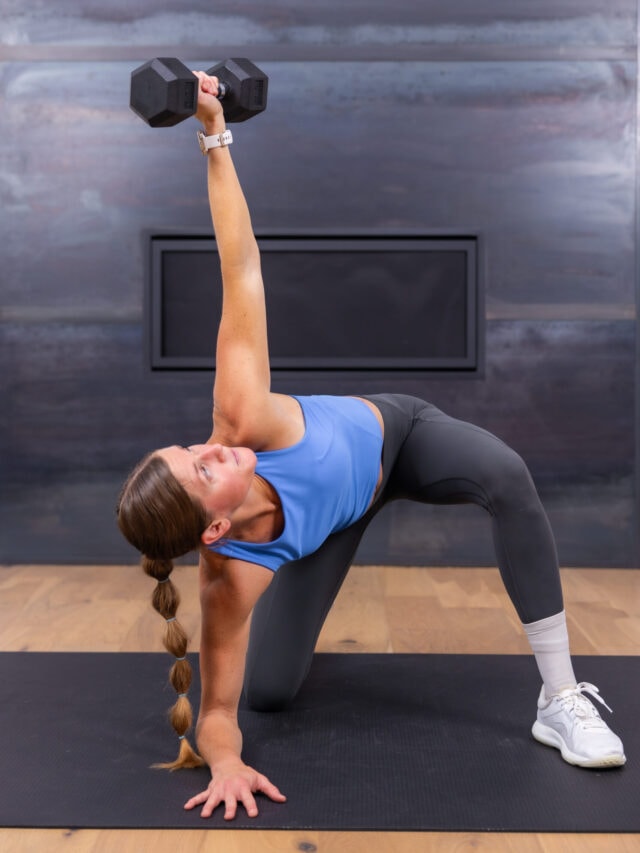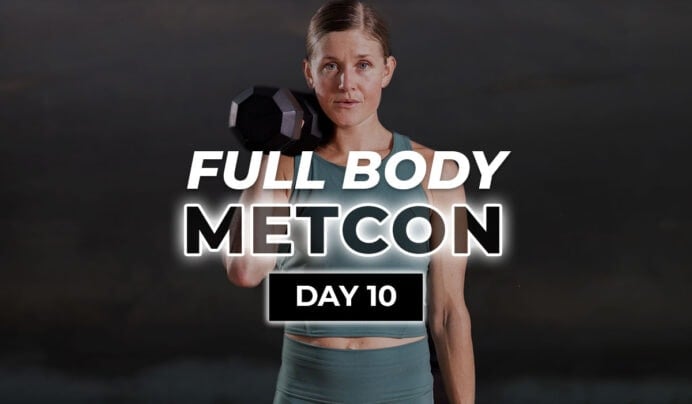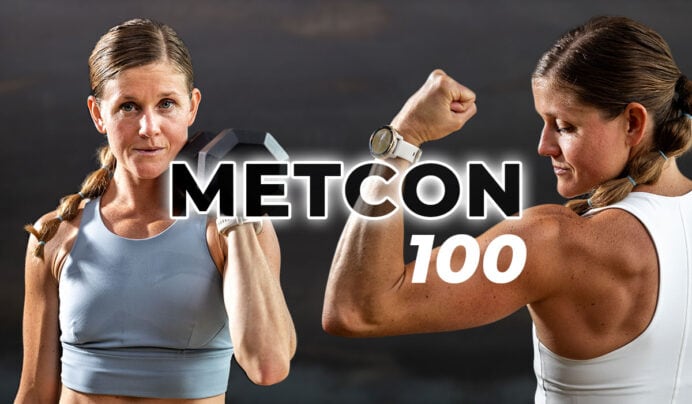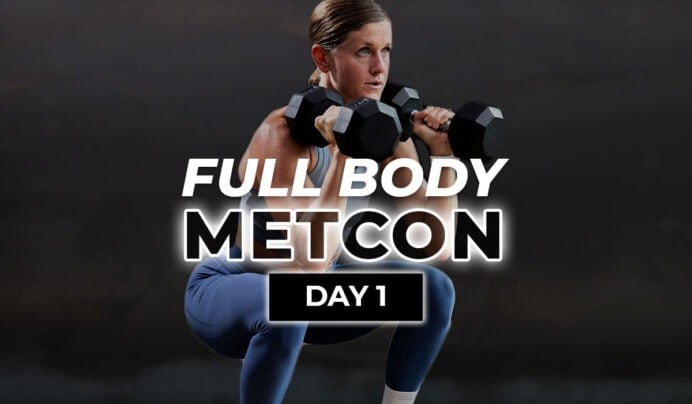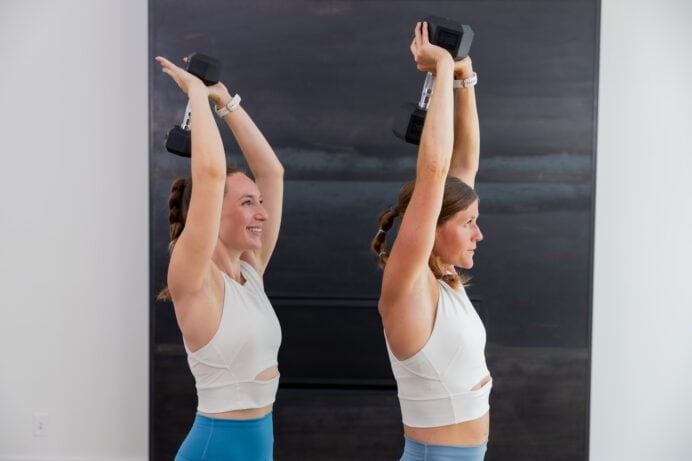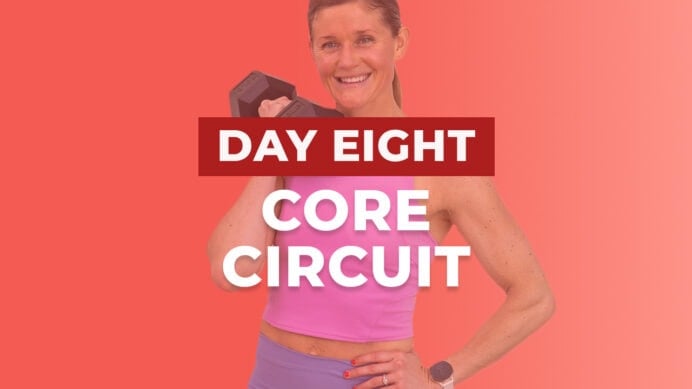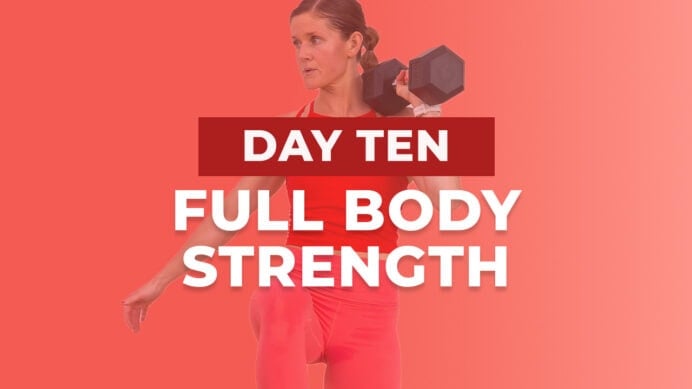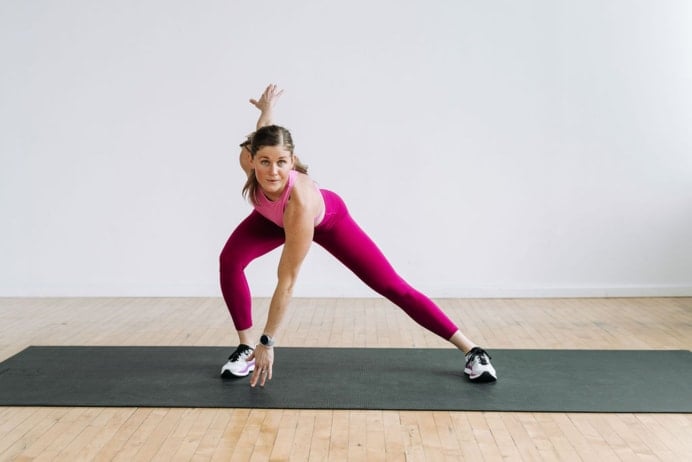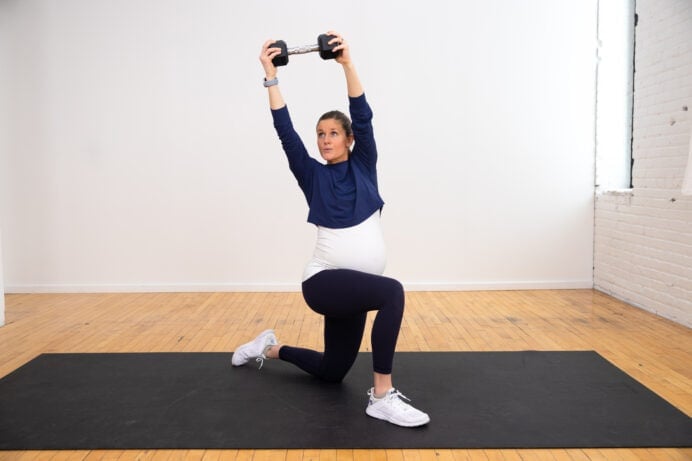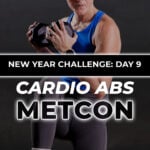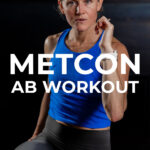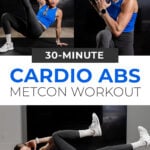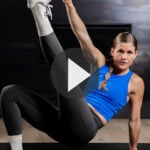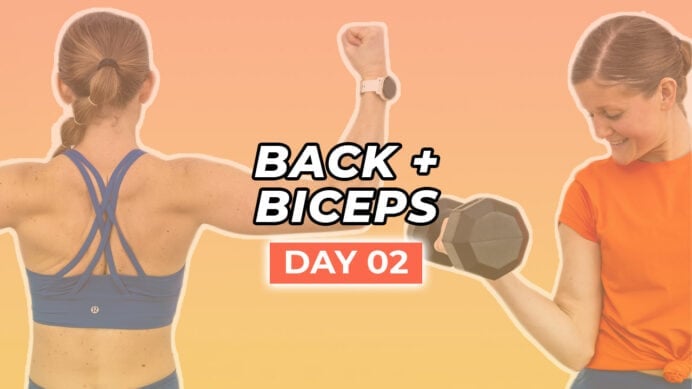
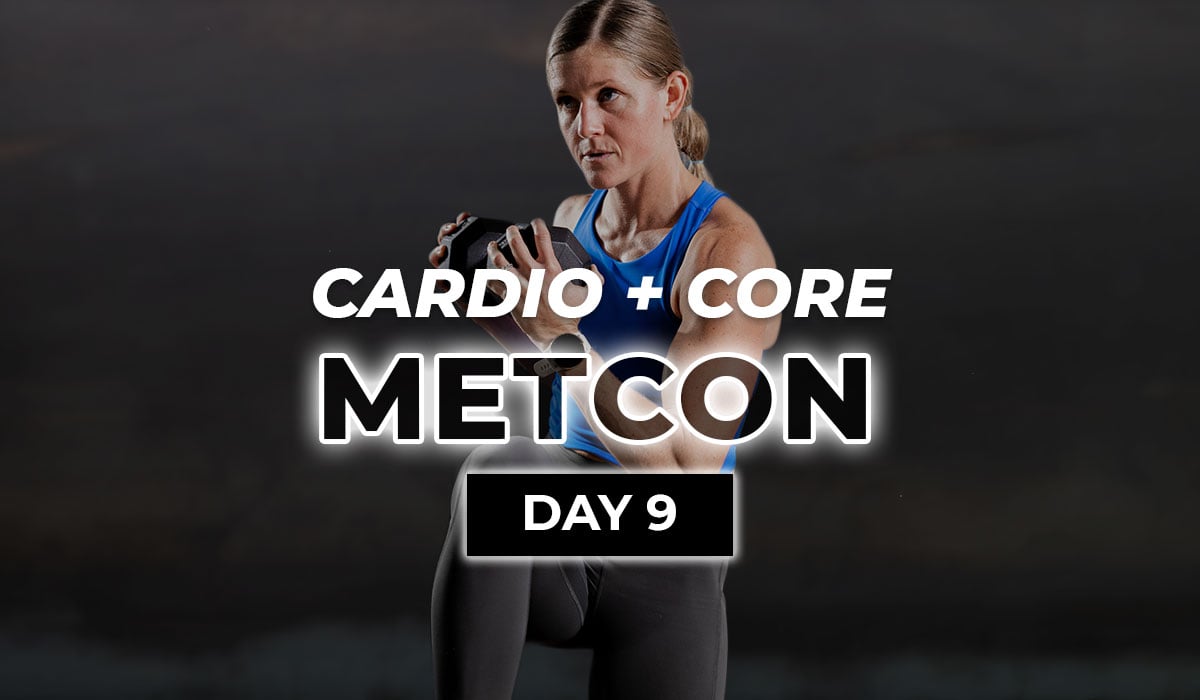
30-Minute Bicycle Crunches Workout (MetCon, Day 9)
Build core strength and challenge your cardiovascular endurance with this bicycle crunches workout. This full body workout combines core training, cardio conditioning and mobility exercises. Challenge yourself to complete 100 bicycle crunches by the end of this workout.
This is DAY NINE of our MetCon 100 Program.
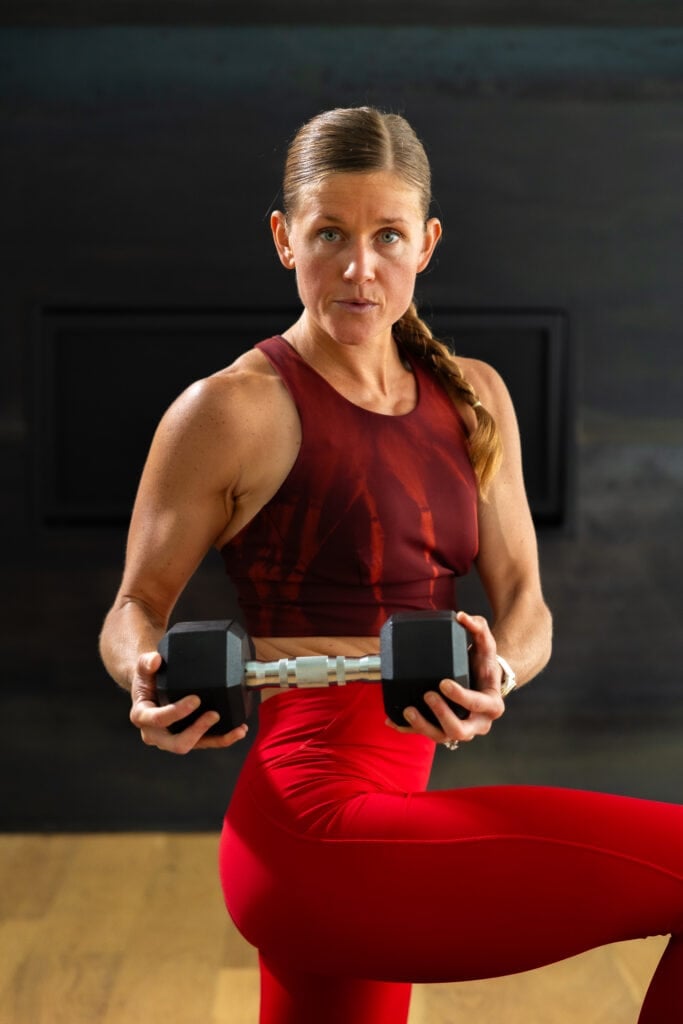
LET’S GET STARTED
Download Your FREE Workout Plan Here
Challenge your total body strength and endurance with this bicycle crunches workout.
Day nine of our 2-Week MetCon 100 Program challenges you to complete 100 bicycle crunches.
The bicycle crunch is an effective core exercise that targets the upper ab muscles, the deep core and the obliques.
Bicycle crunches encourage you to activate and challenge your entire core. This bodyweight exercise is an excellent way to work all the major muscle groups in the core without any gym equipment and can be modified for beginners or advanced athletes.
Don’t want to crunch today? You can follow the workout modifier in the video and perform overhead dumbbell marches instead.
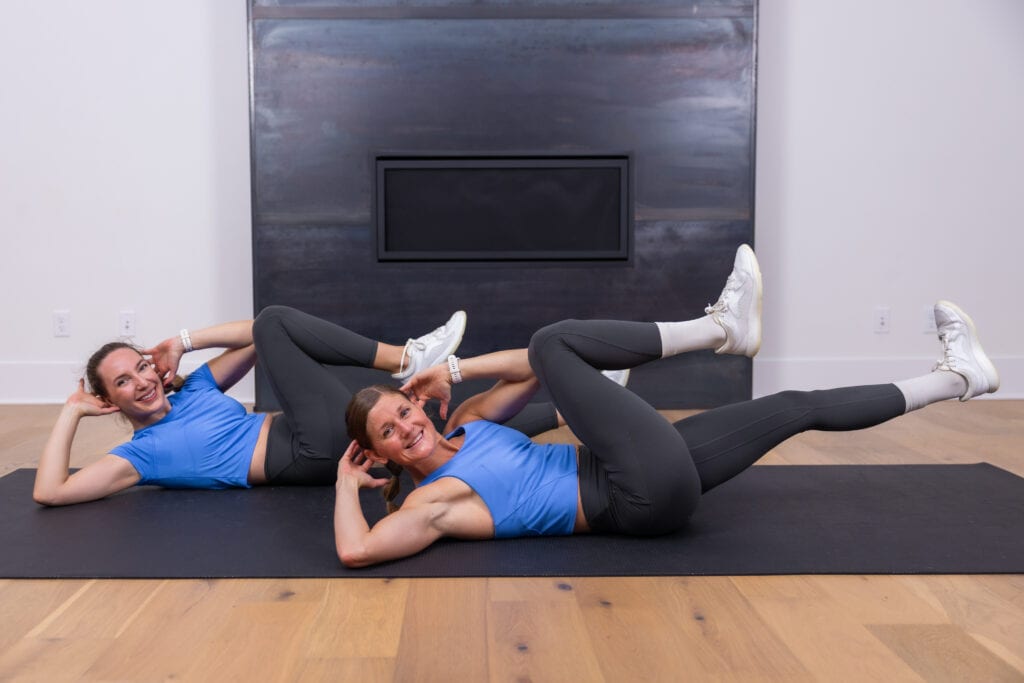
Bicycle Crunches FAQs
Bicycle crunches are an effective strength and cardio exercise for the abs. They target both the superficial and deep core muscles, are an efficient way to fatigue the abs and core, and can be done anywhere because they require no equipment. Bicycle crunches are a great exercise to build a strong core, which increases stability and reduces risk of injury.
This exercise primarily targets your rectus abdominis (or “six-pack” ab muscles), external obliques (your sides) and hips. Additionally, lifting the legs off the ground and pedaling them in a bicycle crunch is a great way to work the transverse abdominis or deep core muscles (a tough group to target). For a well-rounded ab routine try this 10-Minute Daily Ab Workout.
Bicycle crunches help to build muscle, which can help reduce belly fat. That said, a combination of consistent factors will ultimately contribute to weight loss. A well-rounded workout plan, eating in a calorie deficit, and increasing your resting metabolic rate are important, too.
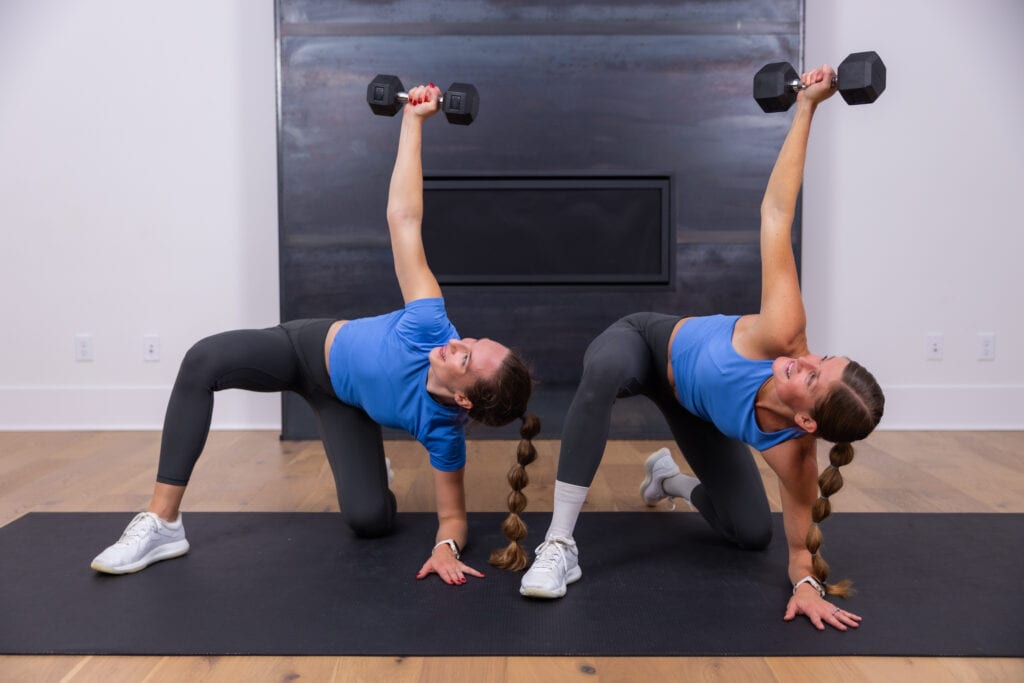
30-Minute Bicycle Crunches Workout (MetCon, Day 9)
Build core strength and challenge your cardio conditioning at home with this effective bicycle crunches workout.
This metabolic conditioning workout challenges you to complete 100 bicycle crunches. Although the muscular focus is the core, we’ll also engage the chest, shoulders, back, glutes, quads and hamstrings.
I suggest doing this cardio and core workout once a week as part of a well-rounded workout routine.
Workout Equipment:
One medium-to-heavy dumbbell. I suggest anywhere from 8-25 lbs. We’re using 15-20 lb dumbbells in this workout.
Option to add a plyo box (or sub a bench/chair).
Shop My Dumbbells
DISCOUNT CODE: NMLTQ5
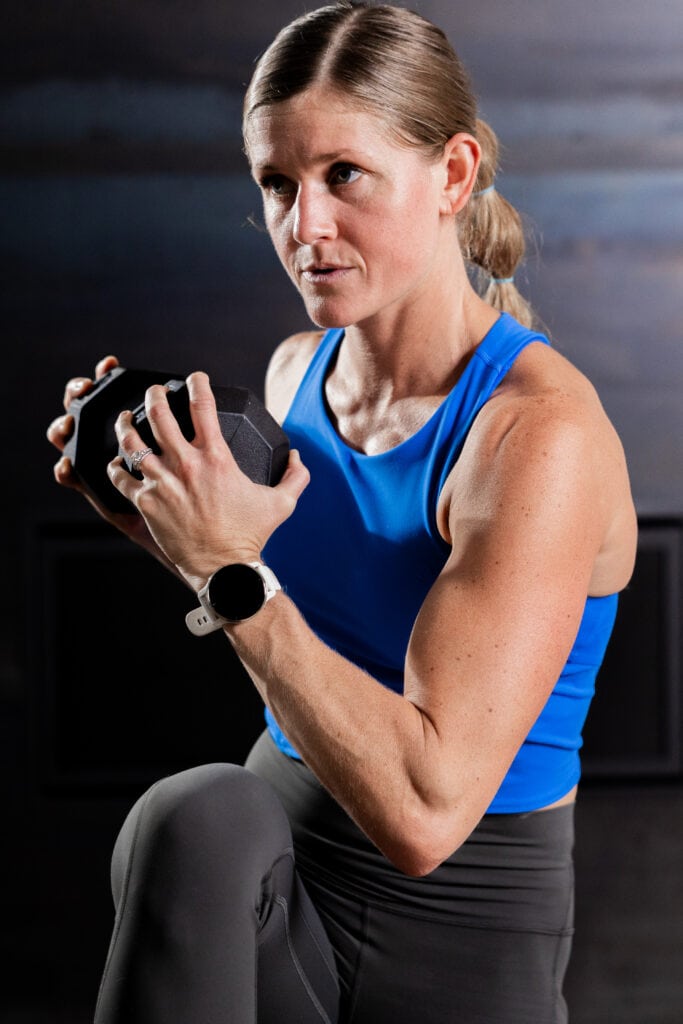
Workout Instructions:
Follow along with the guided Bicycle Crunches Workout on YouTube, led by certified personal trainer and fitness instructor, Lindsey Bomgren.
Your Workout Looks Like This:
- 4 Circuits (one core strength exercise and one cardio exercise in each circuit)
- Timed Intervals (30 seconds work, 15 seconds rest. Complete as many reps as you can in the timed interval.)
- Repeat Each Circuit x2 Sets
- Perform One Mobility Exercise (for 50 seconds between circuit)
- Perform 20 Bicycle Crunches or Overhead Marches After Each Circuit For A Total of 100 Bicycle Crunches or Overhead Marches
Workout Outline
CIRCUIT ONE:
- Core: Single Leg Squat to Box and Dumbbell Press Out
- Cardio: Single Leg Runners
CIRCUIT TWO:
- Core: Half Kneeling Windmill
- Cardio: Lateral Shuffle and Dumbbell Press
CIRCUIT THREE:
- Core: Dumbbell Drag and Kick Sit
- Cardio: Towel Slam Jacks
CIRCUIT FOUR:
- Core: Copenhagen Plank
- Cardio: Burpee and Alternating Toe Tap
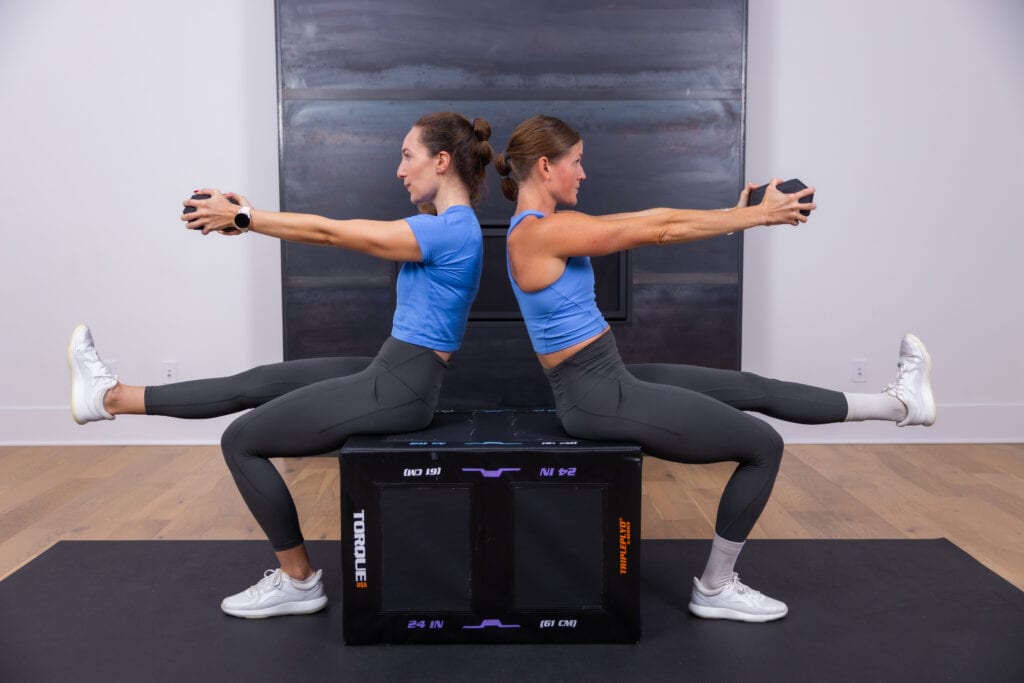
Prefer to Watch On YouTube?
9 Cardio and Ab Exercises
Bicycle Crunch
Targets: Rectus abdominis, transverse abdominal muscles, obliques and hips.
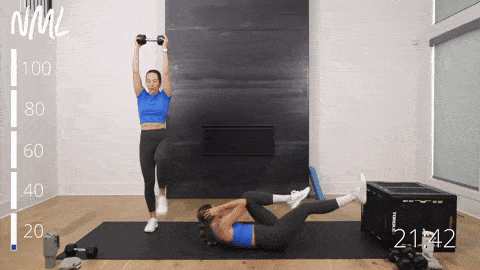
How To Do A Bicycle Crunch
- Start lying flat on your back, lower back pressing firmly into the mat. Bring your legs to a raised 90 degree bend.
- Lift your head, neck and shoulder blades off the ground (avoid straining your neck). Place your hands behind your head and think about pressing your head into your fingertips.
- Lift your right elbow towards your left knee as you extend your right leg long. Aim to touch the left elbow to the mat.
- Slowly return to the starting position and repeat on the other side. Pulling your left elbow towards your right knee as you extend your left leg long, right elbow touches the mat.
- Continue to repeat this ‘bicycling’ movement, alternating knee to elbow crunches.
Modification: Option to perform an overhead dumbbell march.
Single Leg Squat to Box and Dumbbell Press Out
Targets: Legs, glutes, quadriceps (thighs), hamstrings, chest, shoulders and core.
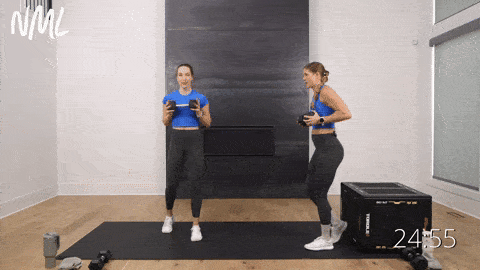
How To Do A Single Leg Squat to Box and Dumbbell Press Out
- Start standing in front of your box or bench, feet shoulder-width distance apart, knees slightly bent, core engaged. Hold a dumbbell horizontally between both hands at your collarbones.
- Shift your weight into your right foot to find a balance position.
- Lower down into a squat position, lowering your hips down to tap your glutes to the box behind you. Both knees bent at a 90-degree angle, left foot raised off the ground.
- At the bottom of the squat, press the dumbbell directly out in front of you at shoulder height. Hold for a moment before pulling the dumbbell back in towards your chest.
- Drive through your right heel to stand tall, squeezing your glutes. Maintain the balance element, keeping the left foot raised off the ground.
Modification: Option to omit the single leg squat and perform a staggered squat and dumbbell press out.
Single Leg Runners
Targets: Lower body power muscles — glutes, hamstrings, quads, calves, hips and core.
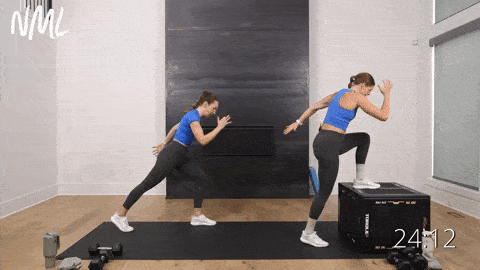
How To Do A Single Leg Runners
- Start standing, feet shoulder-width apart, knees slightly bent. Place your right foot flat on top of a box or bench, left foot is on the ground. Keep a soft bend in your right knee.
- Drive through your front right heel to explosively drive your left foot up to meet the right. Hold for a brief moment before immediately stepping the left foot back again.
- Land softly, then repeat.
Modification: Perform a step back and knee drive from the ground.
Half Kneeling Windmill
Targets: Obliques, abs, upper back, outer glutes, inner thighs, upper body and shoulders.
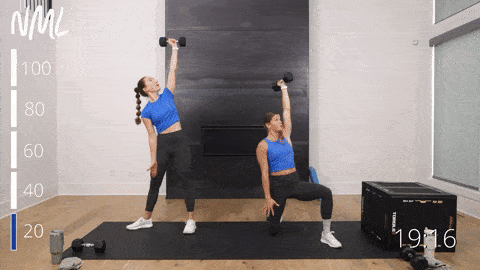
How To Do A Half Kneeling Windmill
- Find a half kneeling position. Feet shoulder width apart, left knee on the ground and right foot planted on the floor. Shoulders are stacked over hips.
- Hold one dumbbell in your right hand, directly above your shoulder.
- Rotate your right foot out 45 degrees, left toes pointing straight back.
- Focus on creating and maintaining length through your waist as you hinge at the hips, sliding your left arm down your left leg. Try to get so low that your left elbow reaches the mat. Keep your right hand directly above your right shoulder, maintaining a straight line with the dumbbell. Range of motion will look different for everyone
- Then, squeeze through your obliques to pull your torso back upright, returning to starting position.
Modification: Option to perform windmills from a standing position.
Lateral Shuffle and Dumbbell Press
Targets: The entire core, specifically the deep stabilizing muscles of the core; hips, glutes, shoulders and upper body.
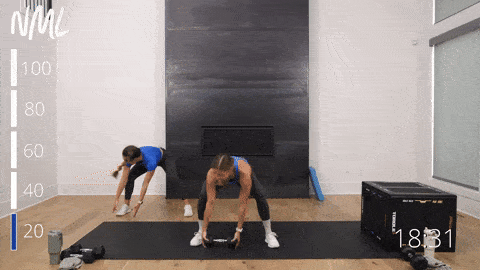
How To Do A Lateral Shuffle and Dumbbell Press
- Hold a dumbbell horizontally between your hands at your chest (one head of the dumbbell in each hand).
- Take one large lateral shuffle to your left, sitting your hips back into a low squat as you press the dumbbell towards the ground, down near your left foot.
- Then drive through the heels to stand tall. Simultaneously pull the dumbbell back to chest height as you shuffle back to center.
- Take one large lateral shuffle to your right as you plant your right foot and pivot your left foot (left toe pivots right, following the hips as they turn to the right). Push the dumbbell overhead and to the right (turning your torso to the right as you do so).
- Bring the dumbbell back to your chest as you pivot and move back towards center to repeat the entire movement.
Modification: Option to omit the dumbbell, performing lateral shuffles and reaches with your bodyweight.
Dumbbell Drag and Kick Sit
Targets: Shoulders, back, quads, hips, hip flexors, calves, abs, obliques and core.
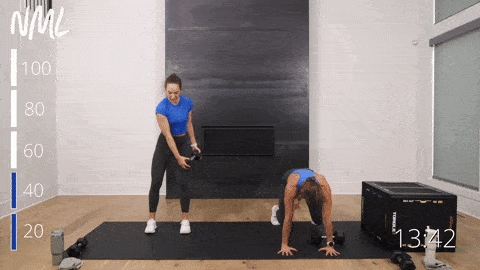
How To Do A Dumbbell Drag and Kick Sit
- Start in a table top position (quadruped) on all fours; shoulders stacked over wrists and hips stacked over knees. Place one dumbbell horizontally on the mat just behind your right hand.
- Then, find a bear crawl position by tucking your toes and lifting your knees to hovering just 1-2 inches off the mat. Back is flat, shoulders stacked over wrists.
- Reach your left hand across your body to grab the dumbbell and drag it across your midline. Dumbbell now sits on the mat just behind your left hand.
- Perform a kick sit by turning the left foot outward (toes face outward). As you do so, bring your opposite leg (right leg) under and through your body while your right hip slightly brushes the ground as the right leg extends. Weight is in your left foot and right hand, right foot and left hand are off the mat.
- Pull your right leg back through to return to the starting position. Repeat the dumbbell drag, this time using the right hand to pull the dumbbell across your midline. Then perform a kick sit on the opposite side.
Modification: Perform a crossbody chop and crunch. Hold a dumbbell horizontally between your hands, outside of your right hip. Drive the dumbbell crossbody, extending your arms up overhead and to the left side. Lower the dumbbell to your chest, then perform a crossbody crunch and knee drive on the right.
Towel Slam Jacks
Targets: Legs, glutes, quads, hamstrings, outer glutes (side butt), inner thighs, calves and core.
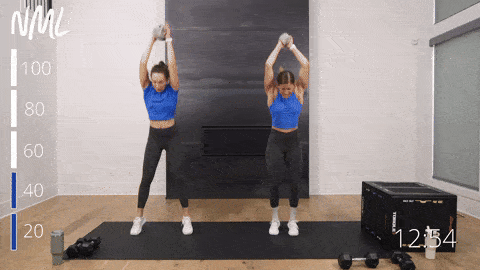
How To Do Towel Slam Jacks
- Start in an athletic stance or loaded squat position, with your feet shoulder-width distance apart and a slight bend in your knees. Hold a towel in both hands straight overhead.
- With your chest upright and your core engaged, “jack” your feet out into a sumo squat (feet are wider than your shoulders).
- Land softly in a low squat, throwing the towel to the ground between your feet.
- Then pick up the towel as you “jack” your feet into a narrow stance, feet hip-width distance apart as you stand tall, driving the arms overhead.
Modification: Option to omit the jumping jack and perform towel slams.
Copenhagen Plank
Targets: Internal and external oblique muscles (the muscles that run along the side of your core), transverse abdominus, hip abductors and hip adductors.
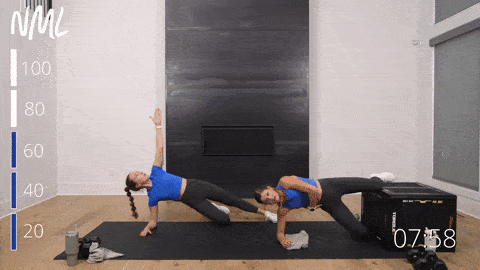
How To Do A Copenhagen Plank
- Start by lying on left side of body, left elbow resting on the floor directly beneath left shoulder. Extend both legs out to the right side, option to extend the right arm toward the ceiling.
- Place the right knee on top of a bench and rest the left knee on the floor. Option to place the right foot on the bench if you’d like to make this more challenging.
- Engage your core as you drive through the left elbow to lift your hips and your left knee off the floor.
- Gaze forward and maintain a straight line from head to knee.
- Then, lift the left knee off the ground, pulling it up to meet the right knee.
- Hold for a moment, then lower the left knee back towards the ground with control and repeat.
Modification: Hold a modified side plank.
Burpee and Alternating Toe Tap
Targets: Upper body (chest, arms, back, shoulders), lower body (legs, glutes, hips) and core.
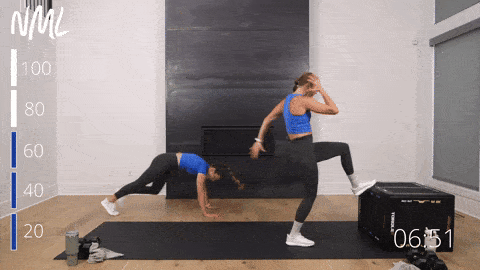
How To Do A Burpee and Alternating Toe Tap
- Start standing a few feet away from your box or bench, feet shoulder-width apart, arms at your sides.
- Bend your knees and drop your hips as you lower into a squat position, then place your hands on the floor directly in front of your feet.
- Shift your weight into your hands as you jump your feet back to softly land on the balls of your feet in a high plank position. Your body should form a straight line from your head to heels.
- Elbows fall back towards your body as you lower your chest towards the ground, bringing your chest to meet the floor. Press back up and return to high plank.
- Jump your feet up, landing outside your hands in a loaded squat position. Then drive through your legs to explode up, reaching arms overhead as you stand tall.
- At the top of the movement, perform a knee drive on the right leg by pulling the right knee in towards the chest, tapping the right toes to your box.
- Place the right foot back on the floor and repeat the burpee. Alternate the knee drive and toe tap after every burpee.
Modification: Perform walking burpees, stepping your feet in and out of plank position rather than jumping. Perform alternating knee drives at the top of the movement but omit the toe tap to box.
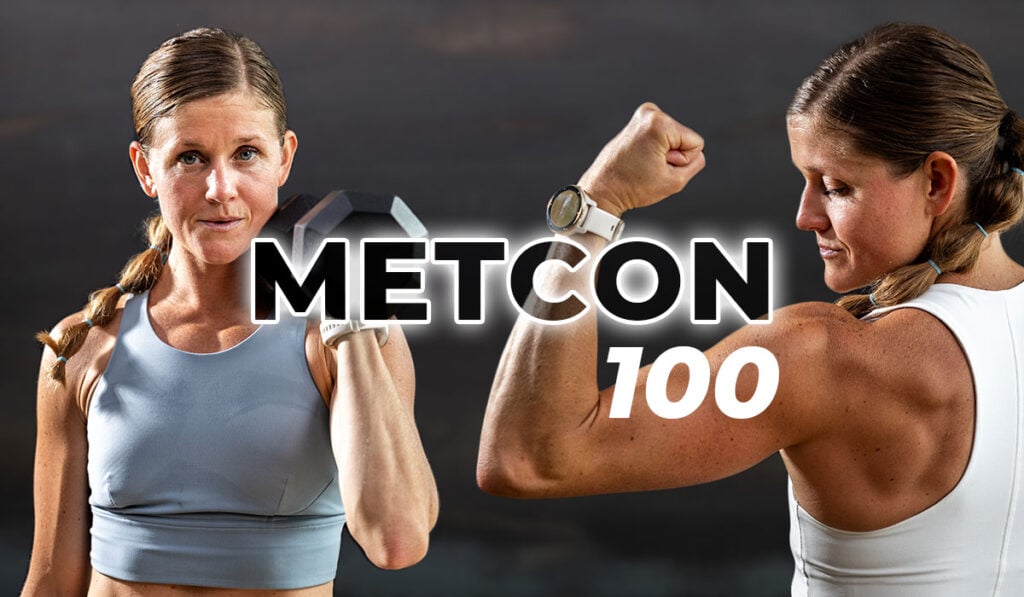
MetCon 100: FREE Metabolic Conditioning Program
A 2-week metabolic conditioning program designed to show you that you’re stronger than you think.
If you liked this abs and cardio workout at home, download the FREE, 2-Week Workout Plan.
Up Next:
See AllPin This Workout: Bicycle Crunches Workout (MetCon, Day 9)
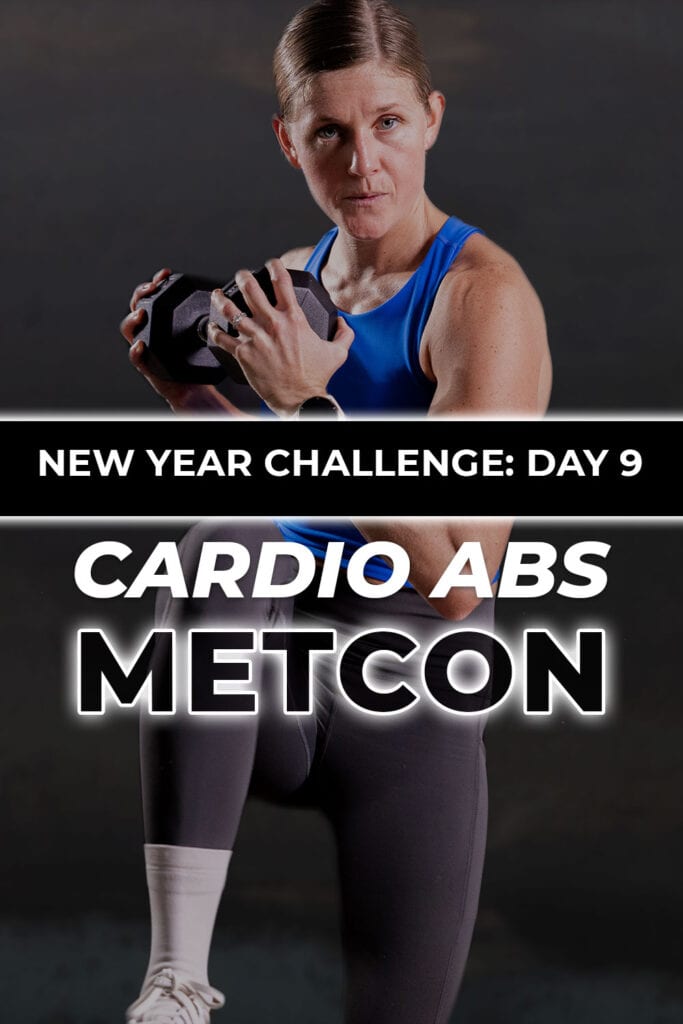
More Abs and Cardio At Home:
This post includes affiliate links. I do earn a commission for products purchased using these links (at no additional cost to you). Thank you for supporting Nourish Move Love, making the content you see on this blog possible.










